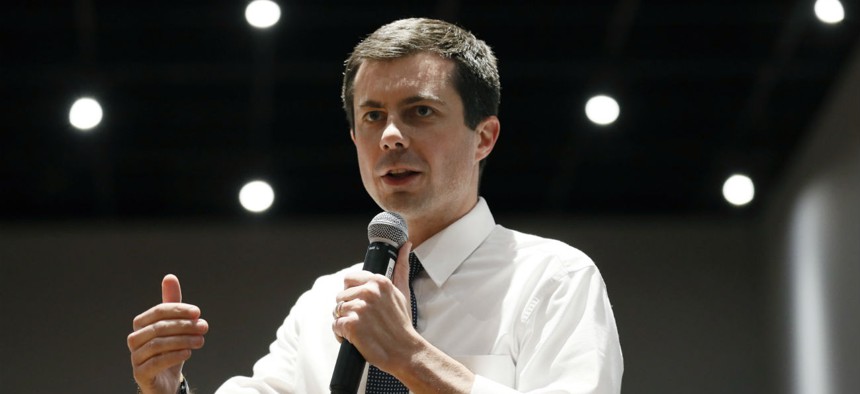
Democratic presidential candidate and South Bend, Ind., Mayor Pete Buttigieg speaks during the Iowa Farmers Union Presidential Forum last week. Charlie Neibergall/AP
Buttigieg's Consulting Career Included Work on a Report Suggesting USPS Slash Career Workforce
Presidential candidate says he only helped the Postal Service generate ideas for new revenue streams.
Democratic presidential candidate Pete Buttigieg contributed to a series of recommendations to improve the financial footing of the U.S. Postal Service that included slashing the career workforce, reducing benefits and closing processing plants.
The South Bend, Indiana, mayor worked on the report while a consultant at McKinsey & Co. With mail volume plummeting, USPS hired McKinsey to generate ideas for cutting costs and growing revenues. The firm delivered its report with an array of proposals in 2010, though a campaign spokesman said Buttigieg’s work specifically focused only on the revenue side.
McKinsey cited as a “key action” the need to replace departing career employees with non-career counterparts. Non-career workers earn less generous pay and benefits than their career counterparts. The report suggested USPS take advantage of “natural attrition” and said its existing efforts were insufficient.
“The USPS has been responsive to declining volume, but recent work hour reductions will become increasingly difficult to replicate,” McKinsey wrote in the report, noting that most of the cuts had come at the expense of non-career employees and overtime.
The company said that increasing the number of non-career employees could have served as a potential upside to the Postal Service’s financial situation, while a potential downside could have been Congress requiring the agency provide those workers with health care. USPS extended some health care benefits to non-career employees in 2013 to stay in compliance with the 2010 Affordable Care Act.
Other proposals in the report included reducing or eliminating pricing discounts provided to nonprofits, ending restrictions on closing post offices, reforming price caps to which the Postal Service is subject, and changing delivery standards and frequency. McKinsey suggested USPS bring delivery down to as little as three days per week. Postal management has suggested moving to five-day delivery, but those efforts have stalled due to legislative resistance.
The Postal Service eventually adopted a proposal to scale back its quickest delivery window from one-to-three days to two-to-five days. The change enabled the agency to shutter 141 processing plants in 2012. As USPS pushed for more comprehensive legislative reform, it never fully implemented a planned second phase of closures, but still fully shuttered 17 facilities and partially consolidated 21 more. The agency’s inspector general found last year the Postal Service realized just 5% of the savings it projected over a two-year period from the mail delivery slowdown and the subsequent facility closures.
McKinsey also proposed creating more public-private partnerships. USPS established such a partnership with Staples in 2013, in which postal services were offered in 80 of the store’s retail locations. Critics said the arrangement allowed USPS to use cheaper, non-union labor. The National Labor Relations Board ruled in 2015 the arrangement illegally violated the Postal Service’s collective bargaining obligations. USPS ended the partnership in 2017.
To further cut workforce costs, McKinsey suggested USPS “bring federally mandated benefits payments more in line with the private sector.” No such changes have taken place, but postal management floated such reductions in a business plan it presented to Congress earlier this year.
All told, McKinsey estimated its proposals could stem the Postal Service’s losses by $123 billion by 2020.
A spokesman for the Buttigieg campaign said the candidate did not work on the workforce reduction part of the report.
“There was a cost cutting side and a revenue side,” the spokesman said. “Pete was strictly on the revenue side, working to come up with ideas to generate revenue.”
In addition to enabling the Postal Service to charge more, other revenue ideas in the report included offering promotions to incentivize mail usage, expanding package services, and growing the number of products and services available at post offices.
Those proposals contributed less than 2% toward the total savings offered in the McKinsey report.







